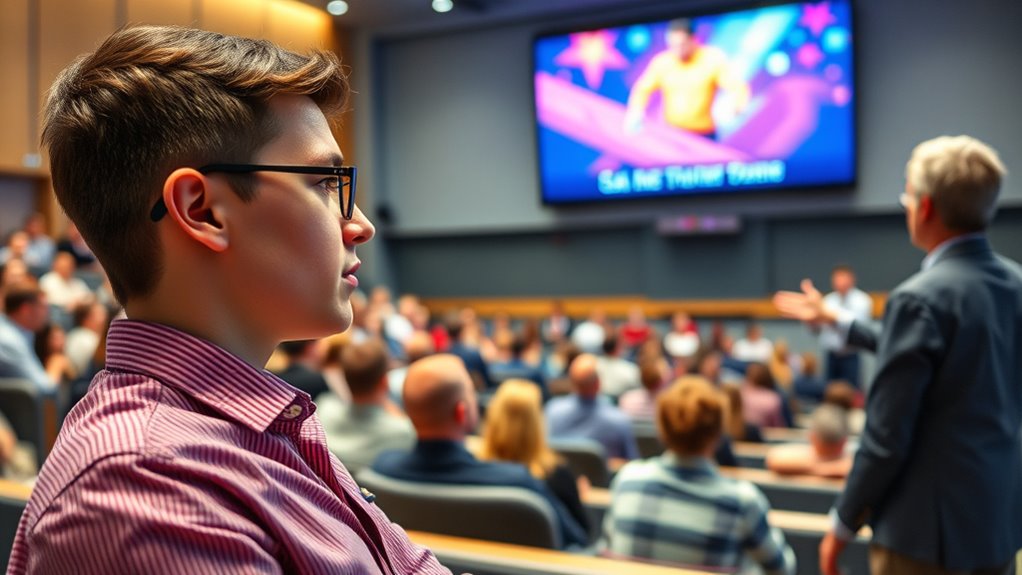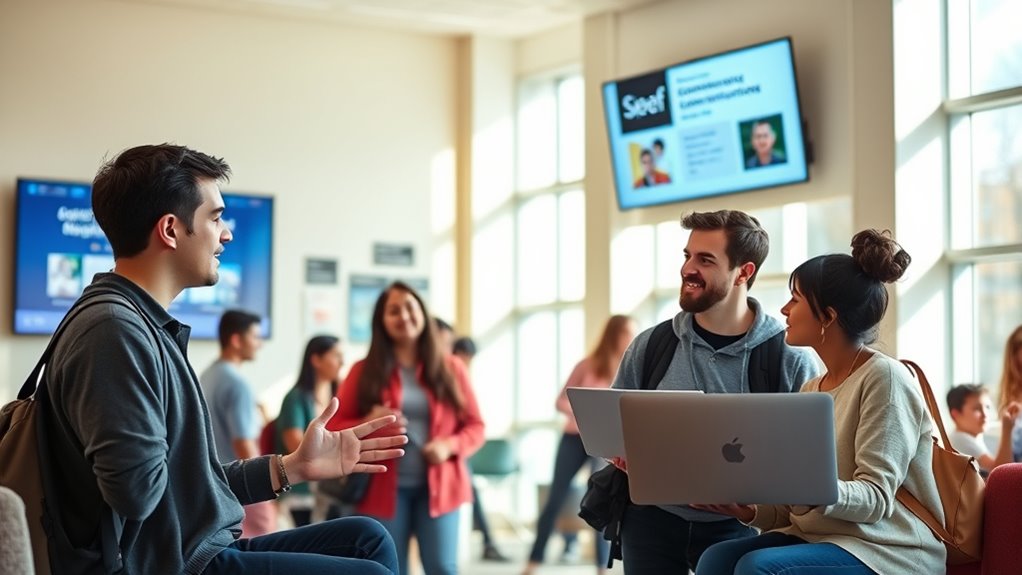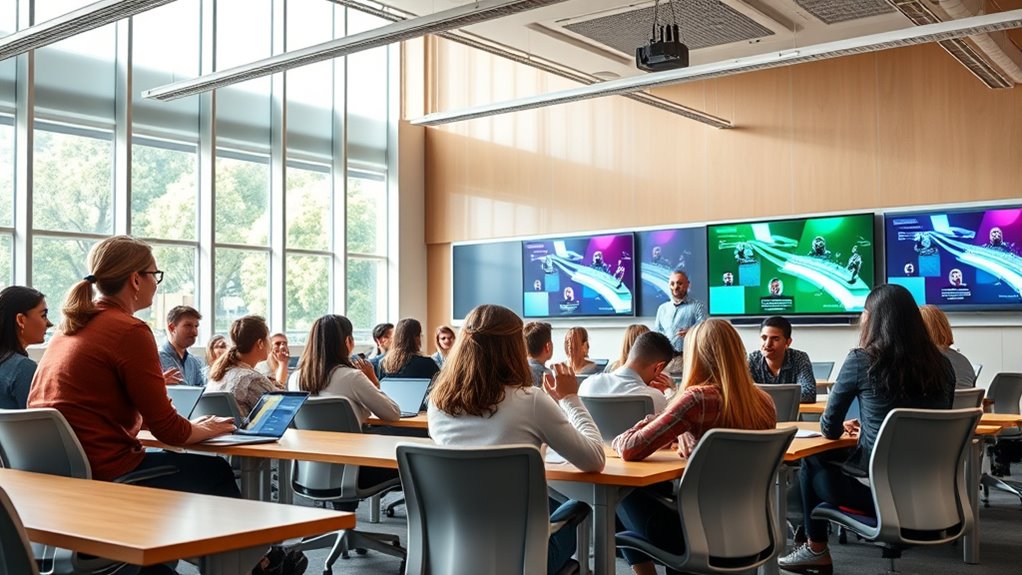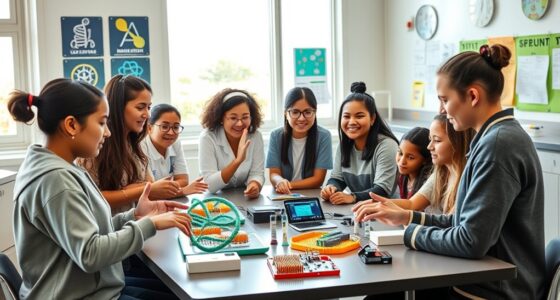Universities support deaf and hard-of-hearing students through sign language interpreters, real-time captioning, and assistive listening devices, ensuring full participation in classes and campus events. They design accessible classrooms, train faculty on inclusion, and promote peer support for social integration. Policies like the ADA help create an inclusive environment. If you want to discover how these accommodations work together to boost your college experience, there’s more to explore below.
Key Takeaways
- Universities provide sign language interpreting and captioning services to ensure full participation in lectures and campus events.
- Assistive technologies like hearing devices, captioning tools, and transcription services enhance accessibility for deaf students.
- Classroom accommodations include optimized seating, visual aids, good acoustics, and inclusive design principles.
- Faculty receive disability sensitivity training and support to create an inclusive learning environment.
- Student support groups, peer mentoring, and advocacy initiatives foster community, confidence, and academic success.
The Role of Sign Language Interpreters on Campus

Sign language interpreters play a crucial role in ensuring that deaf students can fully participate in college life. Your success depends on their sign language fluency and ability to accurately interpret lectures, discussions, and campus events. Interpreters with proper certification are essential because they have demonstrated proficiency and understanding of both sign language and academic content. This certification guarantees that they can handle complex terminology and adapt quickly to different situations. As a student, you rely on these professionals to bridge communication gaps, making sure you receive equal access to learning opportunities. Their presence fosters an inclusive environment, allowing you to engage fully with professors and peers. Proper interpreter training and certification are vital to maintaining high-quality communication. Without qualified interpreters, your college experience would be markedly limited, emphasizing their critical role on campus. Additionally, ongoing professional development ensures interpreters stay current with evolving language and educational needs, further supporting effective communication. Staying informed about advances in sign language interpretation helps interpreters provide more accurate and effective services.
Captioning Services for Lectures and Events

Captioning services provide an essential way for deaf students to access lectures and campus events in real-time. High captioning accuracy ensures you receive correct, easy-to-understand information, which is crucial for maintaining lecture accessibility. When captions are accurate, you can follow discussions without confusion or missing key details. Universities often use real-time captioning tools or professional captioners to deliver this service, allowing you to participate fully in academic activities. Captioning not only helps you keep up with lectures but also supports engagement during seminars, meetings, and campus presentations. Reliable captioning services remove barriers, making campus life more inclusive. With consistent captioning accuracy, you gain equal access to educational content, and you can focus on learning without worry about missing critical information. Utilizing professional voice actors for captioning can further enhance the clarity and natural flow of the captions, improving overall comprehension. Ensuring the use of accurate captioning technology is vital for providing a seamless educational experience for deaf and hard-of-hearing students. Incorporating assistive technologies can also help optimize accessibility and support diverse learning needs. Additionally, implementing mindfulness techniques in training programs can improve the effectiveness of captioning services by reducing errors and enhancing focus among captioners.
Assistive Listening Devices and Technology

Assistive listening devices and technology can considerably improve your classroom experience. Hearing enhancement devices, captioning tools, and real-time transcription make it easier to follow lectures and participate actively. Exploring these options helps you find solutions that best meet your communication needs.
Hearing Enhancement Devices
Hearing enhancement devices have revolutionized the way deaf students access sound in college settings. These devices, including specialized microphones and personal amplifiers, help you hear lectures more clearly by amplifying sound directly into your ears. For students with cochlear implants, these devices can connect seamlessly, improving overall auditory experience. Cochlear implants bypass damaged parts of your inner ear, allowing you to interpret sounds more effectively. Using hearing enhancement devices, you can better participate in discussions, follow classroom activities, and engage with peers. Universities often provide or support the use of such technology to guarantee you have equal access to learning environments. These devices empower you to maximize your hearing potential, helping you succeed academically and socially in college. Recognizing soulmate angel numbers can also support your emotional well-being, fostering confidence and resilience as you navigate your academic journey.
Captioning Technologies Utilized
Because spoken words can sometimes be difficult to catch in a busy classroom, colleges utilize various captioning technologies to guarantee you don’t miss important information. These systems enhance captioning accuracy through advanced speech recognition software and seamless technology integration. They ensure real-time, reliable captions that keep you engaged and informed. Many institutions use integrated platforms that connect directly with lecture capture systems, providing synchronized captions during live sessions. Some tools allow you to customize caption size and background for better visibility. Additionally, colleges often combine captioning with other assistive listening devices to create a thorough support system. This approach minimizes missed content, supports your learning, and helps create an accessible classroom environment. The focus remains on delivering precise, timely captions that enhance your academic experience. Incorporating inclusive design principles, such as adjustable caption settings, further improves accessibility for deaf and hard-of-hearing students. As technology continues to evolve, ongoing innovation in captioning ensures that educational accessibility keeps pace with emerging tools and standards. Furthermore, understanding the impact of WWE Raw’s financial influence highlights the importance of technological investments in entertainment and education sectors. Emphasizing cybersecurity considerations, such as data privacy and protection, is also vital in maintaining the integrity of these digital assistive technologies. In addition, advances in assistive listening devices are continually expanding the range of support options available to students.
Real-Time Transcription Tools
Real-time transcription tools, including advanced assistive listening devices and accompanying technology, play a crucial role in ensuring you can follow lectures without missing key information. These tools provide real-time transcription, converting spoken words into text instantly. With high captioning accuracy, they help you stay engaged and understand complex concepts as they’re discussed. Modern devices use sophisticated speech recognition algorithms to improve captioning quality, reducing errors and making content clearer. You can view the transcriptions on screens or personal devices, allowing you to focus on the lecture rather than struggling to catch every word. These tools are essential for creating an inclusive learning environment, helping you participate fully in classroom activities and access information just as your peers do. Additionally, regular updates and calibration of these devices can enhance essential oil safety and performance, ensuring reliable support during lectures. Incorporating assistive technology into your learning routine can further optimize your educational experience, making sure you do not miss vital information. As cyber threats evolve, integrating AI security solutions into assistive devices can further protect sensitive data and improve system reliability, which is increasingly important in digital learning environments. Moreover, ongoing research into speech recognition accuracy continues to improve the effectiveness of these tools, benefiting users with diverse needs. Some systems also integrate with yoga practices to promote mindfulness and stress reduction, which can improve focus during lectures.
Accessible Classroom Design and Layouts

Designing an accessible classroom requires careful attention to layout and seating arrangements to guarantee all students, including those who are deaf, can fully participate. A thoughtful visual layout ensures that visual cues, such as slides and demonstrations, are visible from all seats. Good classroom acoustics help minimize background noise, making speech clearer for students relying on lip-reading or hearing devices. To optimize accessibility, consider these factors:
- Position the instructor at a central, visible point
- Arrange seats to face the instructor directly
- Incorporate visual aids and captioning systems
- Ensure good lighting for visibility and lip-reading
- Use sound-absorbing materials to improve acoustics
- Understanding optimal angles for pinball machines can inform room layout choices to enhance visual and auditory clarity.
These strategies create an environment where deaf students can engage fully and comfortably in the learning process.
Training and Awareness Programs for Faculty and Staff

To support deaf students effectively, you need to prioritize faculty disability sensitivity training and staff communication best practices. These programs help you understand diverse needs and foster inclusive interactions. Implementing them guarantees that everyone on campus can participate fully and comfortably. Incorporating training programs exercises into staff training can also enhance problem-solving skills and adaptability in addressing student needs. Emphasizing inclusive communication methods ensures that all students receive equitable support and engagement.
Faculty Disability Sensitivity Training
Effective faculty disability sensitivity training is essential for creating an inclusive college environment. It enhances faculty awareness of diverse student needs and promotes respectful, effective interactions. Well-designed disability training helps faculty recognize unconscious biases and learn practical strategies to support deaf and hard-of-hearing students. This training often includes understanding legal obligations, effective communication techniques, and cultural competency. Incorporating knowledge of interior design principles can also help create physical spaces that support accessibility and comfort for all students. Additionally, integrating diverse design elements into campus facilities can further promote inclusivity and accommodate varied learning preferences. Recognizing relationships and fostering open dialogue can further improve faculty-student interactions and support systems. Considering physical environment adaptations can significantly impact student comfort and engagement in learning.
Staff Communication Best Practices
How can faculty and staff improve communication to better support deaf and hard-of-hearing students? The key is implementing effective training and awareness programs. Encourage staff to develop sign language proficiency to minimize communication barriers. Regular workshops can teach active listening, clear speech, and respectful interaction techniques. Visual aids and captioning tools also help bridge gaps. Visualize this:
| Environment | Communication Method | Staff Preparedness |
|---|---|---|
| Lecture Hall | Sign language, captions | Trained in sign language |
| Office Hours | Clear speech, visual cues | Aware of communication needs |
| Class Discussions | Written notes, gestures | Sensitive to deaf students |
| Events | Assistive technology use | Familiar with communication tools |
Support Services and Counseling for Deaf Students

Support services and counseling play a crucial role in helping deaf students succeed in college. They provide essential mental health support, ensuring students can address emotional challenges unique to their experiences. Career counseling helps students explore options and develop skills for future employment, tailored to their communication needs. Universities often offer specialized mental health services with interpreters or visual communication methods. Counseling programs focus on building resilience, managing stress, and overcoming social barriers. Accessibility to peer support groups can foster a sense of community and belonging. Additionally, training staff on deaf culture and communication enhances the effectiveness of these services, making sure students feel understood and supported throughout their academic journey.
Peer and Student Organization Initiatives

You can see how Deaf student support groups and peer mentoring programs foster connection and understanding on campus. These initiatives empower students to advocate for themselves and each other. By participating, you help create a more inclusive and supportive college community.
Deaf Student Support Groups
Have you ever wondered how deaf students build a sense of community on campus? Deaf student support groups play a crucial role in fostering peer advocacy and creating safe spaces. These groups offer a platform to share experiences, access resources, and develop leadership skills. They often organize events, workshops, and social gatherings that promote cultural pride and mutual understanding. Through active participation, you can connect with peers who understand your challenges and successes firsthand. Support groups also serve as a voice for advocating for better accommodations, raising awareness, and influencing campus policies. By joining or forming these groups, you help strengthen the community and ensure every deaf student feels supported and empowered throughout their college journey.
- Organizing awareness campaigns
- Hosting cultural events
- Providing peer mentorship
- Facilitating communication workshops
- Collaborating with university administration
Peer Mentoring Programs
Ever wondered how peer mentoring programs benefit deaf students in college? These programs foster peer connections that help students navigate campus life, academics, and social challenges. Through mentorship programs, experienced students provide guidance, share resources, and offer emotional support tailored to deaf and hard-of-hearing students’ needs. Having a peer mentor who understands the unique communication and accessibility challenges creates a safe space for questions and growth. Mentorship programs also promote confidence and independence, helping students build networks and integrate into campus communities. By connecting deaf students with peers who share similar experiences or understand their situation, colleges create inclusive environments that enhance retention and success. Ultimately, peer mentoring programs serve as essential bridges, empowering deaf students to thrive academically and socially.
Student-Led Advocacy
Building on the support provided through peer mentoring, student-led advocacy initiatives empower deaf students to shape their college experience actively. These initiatives, through student-led initiatives and advocacy campaigns, allow you to voice concerns, propose improvements, and foster awareness on campus. You can join or organize groups that focus on accessibility and inclusion, giving you a platform to influence policy and peer perceptions. Student organizations often collaborate with campus administration to implement meaningful change, ensuring your needs are prioritized. Active participation in advocacy campaigns helps create a more inclusive environment for current and future students. By leading these efforts, you not only champion your rights but also inspire others to advocate for broader accessibility and equality. Your involvement makes a tangible difference in campus culture.
Policies Promoting Equal Access and Inclusivity

What policies guarantee that deaf students have equal access and feel included on college campuses? Sign language policies ensure that students who use American Sign Language or other sign languages can communicate effectively with faculty and peers. Accessibility legislation, such as the Americans with Disabilities Act (ADA), mandates that institutions provide necessary accommodations, including interpreters and captioning services. These policies create a framework for inclusive environments where deaf and hard-of-hearing students can participate fully in classes, extracurricular activities, and campus events. Colleges also develop inclusive hiring practices and training programs to foster awareness and respect. By adhering to these policies, universities demonstrate their commitment to equal opportunity, making certain that deaf students are not marginalized but instead integrated into campus life.
Challenges and Areas for Improvement in Accessibility

While policies like the ADA and sign language services set important standards for accessibility, many deaf students still face significant obstacles on college campuses. Communication barriers often persist due to inconsistent interpreter availability or lack of real-time captioning. Technology gaps hinder effective learning, especially when classrooms lack up-to-date assistive tools. These issues can lead to feelings of exclusion and hinder academic success. Universities need to address these challenges by improving infrastructure and training staff.
- Insufficient real-time captioning in lectures
- Limited availability of qualified sign language interpreters
- Outdated or incompatible assistive technologies
- Lack of awareness among faculty about accessibility needs
- Inadequate resources for remote or hybrid learning environments
Success Stories and Best Practices From Universities

Many universities are leading the way by implementing innovative solutions that enhance accessibility for deaf students. They leverage assistive technology like real-time captioning, video relay services, and sign language interpreting to create inclusive classrooms. These institutions also prioritize accessibility awareness training for faculty and staff, ensuring they understand students’ needs and foster a supportive environment. Some universities have established dedicated resource centers focused on assistive tools, providing hands-on support and training. Others promote peer mentoring programs to build community and confidence. These best practices demonstrate how proactive investments in technology and awareness can notably improve student success. By sharing these success stories, universities inspire others to adopt similar strategies, making higher education more equitable for all students.
Frequently Asked Questions
How Do Universities Address Communication Barriers Outside of Classroom Settings?
You’ll find universities addressing communication barriers outside the classroom by offering services like sign language interpreters and captioning. They also promote peer mentoring programs, connecting deaf students with trained peers who understand their needs. These initiatives help you engage fully in social activities, campus events, and daily interactions, ensuring you feel included and supported beyond academic settings. This all-encompassing approach makes your college experience more accessible and welcoming.
What Funding Options Are Available for Accessibility Services on Campus?
Back in the day, funding options for campus accessibility might seem like a wild west, but today you have solid choices. Universities access funding sources like government grants, private donations, and accessibility grants to support services for deaf and hard-of-hearing students. These funds help cover interpreters, captioning, and technology, ensuring you get the support you need. Always explore campus resources or speak with disability services to learn about available funding opportunities.
How Do Students Access Mental Health Support Tailored for Deaf and Hard-Of-Hearing Individuals?
You can access mental health support tailored for deaf and hard-of-hearing students through specialized services on campus. Universities often offer sign language therapy and counseling with interpreters to guarantee clear communication. Peer support groups also play a crucial role, allowing you to connect with others who understand your experiences. Reach out to the campus disability services or counseling center to learn about these resources and find the support that fits your needs.
Are There Specific Accommodations for Deaf Students in Online or Hybrid Courses?
Think of online and hybrid courses as bridges connecting you to learning. Universities often provide sign language interpreters and captioning services to guarantee you don’t miss a beat. These accommodations translate lectures and discussions into accessible formats, making the digital classroom a space where you can fully participate. With these tools, you stay engaged, just like everyone else, breaking down barriers across virtual and hybrid learning environments.
How Do Universities Measure the Effectiveness of Their Accessibility Programs?
You might wonder how universities gauge the success of their accessibility programs. They typically rely on technology integration, like captioning and assistive devices, to enhance learning. Additionally, student feedback plays a vital role, providing insights into what’s working and what needs improvement. By combining these approaches, universities can continually assess and improve their accessibility efforts, ensuring they meet the diverse needs of all students effectively.
Conclusion
By embracing thorough accessibility measures, you create an inclusive environment where deaf and hard-of-hearing students thrive. Imagine a student attending lectures with real-time captioning and sign language support, fully engaging without barriers. When universities invest in technologies, training, and policies, they foster equality and empower every learner. Your commitment to continuous improvement ensures all students feel valued, supported, and able to succeed academically and socially on campus.











